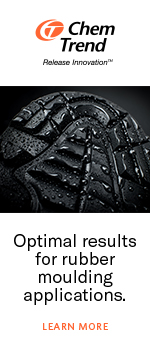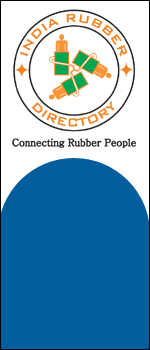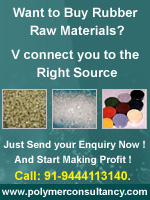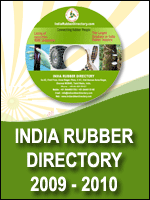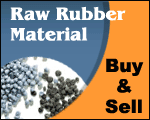Articles - Rubber Technical Papers
EXTRUDED AND CALENDERED GOODS
N.R. Peethambaran
Extruded Goods
Extrusion procdess is one of the major manufacturing techniques of rubber
industry and a large number of rubber products are produced by this technique.
1. Tread Rubber
The process of removing old worn out tread and replacing it with a new
tread surface is called Retreating. Tread rubber is used to replace the
worn-out tread. Tread rubber is used in "die size" or "strip"
form. 'Die size' rubber is the rubber, which has been fed into the extruder
and extruded into the shape desired. Die sises are given in three or more
sets of numbers. The first two parts of numbers indicate the crown and
base width in inches with the last number in each sequence indicating
multiples of 1/8 inch. Each sequence of numbers after the first two indicates
thickness of thread rubber in multiples of 1/32 inches. A die size of
52-76-13-11-13 means that the crown is 51/4 inches wide, the base is 7
3/4 inches wide and the tread has a valley contour with the tread rubber
being 13/32 inch thick on each shoulder and 11/32 inch thick at the tread
centre. As the die sizes are extruded a natural rubber cushion gum is
applied to the ban of the tread rubber to provide a back surface so that
the tread rubber will adhere to the buffed surface of the tyre.
A Retread compound (Camel back and slab) is expected to give the same
performance as the original treads which it replaces. A retread compound
is also expected to have long storage life. Typical compound recipes for
a heavy-duty Truck Tyre and Cushion gum are given below.
|
Natural Rubber
|
Tread
|
Cushion gum
|
|
(RSSIV or ISNR-10) |
80.0 |
100.0 |
|
Cis 1,4 polybutadiun |
20.0 |
--- |
|
Zinc oxide |
5.0 |
5.0 |
|
Stearic acid |
2.0 |
2.0 |
|
A.O. PBN |
1.0 |
1.0 |
|
A.O. 4020 NA |
0.5 |
-- |
|
GPF Black |
-- |
30.0 |
|
HAF black |
50 |
-- |
|
Pine tar 7 |
-- |
7.0 |
|
Aromatic oil |
5.0 |
-- |
|
Accelerator DZ |
0.6 |
0.7 |
|
Insoluable sulfur |
2.8 |
2.8 |
The
rubber compound is prepared in a two roll-mixing mill and kept for maturation
for 24 hrs. It is again pre warmed in the mill before feeding into the
extrude.
Water Delivery
Hose
|
Natural Rubber
|
Tube p.b.w.
|
Cover p.b.w
|
|
Tinc Oxide |
100 |
100 |
|
Stearic acid |
5 |
5 |
|
Hard clay |
2 |
2 |
|
FEF black |
180 |
100 |
|
Napthenic oil |
20 |
50 |
|
A.O. PBN |
18 |
15 |
|
P. Wap |
1.5 |
1.5 |
|
CBS |
1.0 |
1.0 |
|
TMTD |
1.0 |
1.0 |
|
Sulfur |
0.1
|
0.1 |
|
|
2.4 |
2.4 |
II Calendered goods
1. Converyor belting
Conveyor belts transport materials at low speed and operate over big
pulleys. A typical belt consists of a carcass and covers (top and bottom).
The function of the carcass is to carry in load while the covers protect
the carcass from wear and tear, shocks, deleterious effects of solvents,
oils, heat, ozone and weathering. Typical compound formulations for the
conveyor belt compounds are given below: -
General purpose Conveyor belt compound
| Natural rubber |
100 |
100 |
| Tinc Oxide |
10 |
5 |
| HAF black |
50 |
--- |
| SRF black |
-- |
30 |
| Stearic acid |
2.5 |
2.0 |
| PPTED CaCo3 |
-- |
60 |
| C.I. Resin |
5 |
5 |
| M.C.Wax |
1 |
-- |
| A.O.PBN |
1 |
1 |
| A.O.4020 NA |
0.5 |
-- |
| Accelerator CBS |
1.0 |
1.0 |
| Sulfur |
2.4 |
2.4 |
2). Transmission Belts
Transmission belts transmit power and operate at high speeds over smaller
pulleys in comparison with conveyor belts. Although flat belts and V belts
both are grouped under a common heading the first type calls for high
flexibility but total non-strechability to avoid loss of efficiency in
power transmission. Compounds for V belts should with stand high speed
flexing and heat while those for flat transmission belt should have good
ageing resistance.
3). Rubber convered Rolls
Rubber convered Rolls find application in many industries
notably paper manufacturing, steel processing textile processing metal
coating and leather finishing. Most rolls are made of oil resistant rubbers
and are generally vary in the range of 20-40 shere A. Most of them are
produced by applying Calendered sheet on the rolls. Calendered rubber
is carefully applied to the care and rolled down either by machine or
by hand. Special care must be taken to prevent the incorporation of air
into the roll. The built roll is then wrapped tightly with cotton for
vulcanisation in an open steam or in an autoclave. In general printing
rollers are made from nitrile rubber, paper rolls from natural rubber.
Leather processing rolls are made from nitrile or EPDM or silecone rubber.
Typical compound formulation for printing Roller is given below: -
| Nitrile rubber |
100 |
| Zinc Oxide |
5 |
| Stearic acid |
1.5 |
| GPF black |
15 |
| Brown facties |
40 |
| Diochy lplhalal |
60 |
| TMTD |
1.0 |
| Sulfur |
2.0 |
4. Hospital and Industrial sheetings
Hospital sheetings are of 3-4 mm thickness and width 36" and is
manufactured by the calendering process. There are different types such
as plain sheetings, fabric reinforced sheetings (Mackintosh) etc. Industrial
sheetings are used for washers and seal, which are required in large number.
These sheets are also available in both plain and fabric reinforced structure.
A typical compound formulation for hospital sheeting are given below.
| RSS IX |
100 |
| Zinc Oxide |
10 |
| Stearic acid |
2 |
| Barium Sulphate |
100 |
| China clay |
80 |
| Titanium dioxide
|
20 |
| Napthenic oil
|
12 |
| Paraffin wax
|
1.5 |
| Antioxidant SP
|
1.0 |
| White factie
|
5.0 |
| Accelerator CBS |
1.0 |
| Sulfur |
2.4 |
5. Tank lining: Calendered sheets are also used in tank and pipe
linings in chemical industries.










